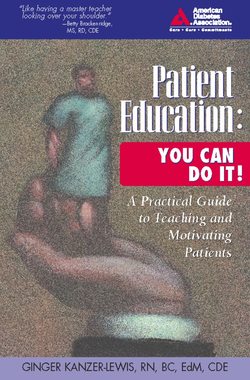Читать книгу Patient Education: You Can Do It! - Ginger Kanzer-Lewis - Страница 10
На сайте Литреса книга снята с продажи.
What Has the Doctor Told You?
ОглавлениеThat is sometimes a difficult situation. If the physician was clear and concise and the patient was able to ask all the questions he or she needed to ask, we are in a much better place than we may be if the physician was vague or distracted.
In this case, I had to relate to a physician that people with diabetes have about four times greater risk of cardiac disease than people without diabetes and that diabetes and CVD interact. Sometimes, the education starts with the people who take care of patients.
Let’s be clear about our medical colleagues. Most of the physicians I have worked with are incredibly committed and dedicated professionals. They work hard, long hours and are determined to give our patients the best care possible, in often difficult circumstances. There are never enough hours, people, or resources to meet the needs of their patients.
A family practice physician has to take care of patients with over 200 different diagnoses and keep up on the disease management changes that occur constantly in our field. It is amazing what they have to continually learn. I salute these colleagues with all my heart and partner with them in all kinds of venues and circumstances.
Some physicians do not take the time or have the energy or interest to keep current and do not rely on the colleagues available to them. They sometimes avoid taking the time to answer questions and expect patients to do as they are told without sufficient information or motivation.
It would be unethical and unprofessional for me to ever denigrate a colleague to a patient, and it often takes all my tack and diplomacy to get out of situations where my patients ask me why the doctor never told them this or that.
For example, I have a patient who is an active 45-year-old man. He has had diabetes for five years, and because he is a friend of mine, he came to me for help. He was told to watch what he ate and take two metformin tablets daily. When I asked him what kind of diabetes he had, he said the doctor told him that he did not have diabetes, just elevated sugars, and to watch himself. He was not told to test his blood or have glycated hemoglobin (A1C) tests done. He was not referred to an educator nor were goals set. It was not until three years later that the physician ordered quarterly A1C, after he apologized to the patient for not having them done earlier.
Diabetes educators have had to live with the terms “borderline diabetes” or “just a little bit of sugar” for years, and it is not acceptable. If the blood sugar is not normal, 90–110 mg/dl,4 then the patient has impaired glucose tolerance. If it is above 126 mg/dl, the patient has diabetes. Short and simple. Calling these conditions anything else is frustrating and often causes delay in the patient’s ability to adapt to a long-term illness. It does nothing to assist the health educator to work more effectively with the patient in goal setting. The physician is doing the patient no favor by delaying a definitive diagnosis.
I have had to call a physician and ask for a diagnosis. One physician told me that he did not want to label the person as diabetic and put them through the stigma and insurance hassles. This is not acceptable in 2003.
